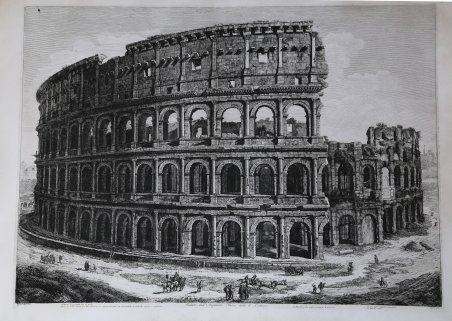Details
Description
LE ANTICHITA ROMANE Tavola tratta dalla serie delle Antichità Romane, composta di 101 tavole, che viene realizzata con il ricavato della e vendita dei rami della Raccolta di cinquanta principali vedute di antichità tratte da scavi fatti in Roma in questi ultimi tempi divise in 40 vedute, edita nel 1817. Con quest’opera, per il numero delle tavole e per il formato prescelto, di grandi dimensioni, l’incisore vuole affermarsi come figura di primo piano nel mondo artistico romano. In quest’opera Rossini si cimenta in un diretto confronto con il suo predecessore G. B. Piranesi che costituisce un punto di riferimento per un incisore di vedute antiche per quanto riguarda l’originalità e l’ampiezza della riproduzione. Il Rossini, oltre a sottolineare la sua influenza nella scelta del titolo e di alcune didascalie, usa frequentemente le medesime inquadrature e identici punti di vista del maestro veneziano. Altro elemento riconducibile a Piranesi è l’uso della luce e dei forti contrasti chiaroscurali. La volontà di voler animare le vedute, restituendo il monumento al suo contesto storico e la propria inadeguatezza nel campo della figura, porta Rossini ad una collaborazione con Bartolomeo Pinelli, incisore romano, interprete e illustratore del costume e della vita popolare; a cui si devono le figure e i gruppi caratteristici che corredano le vedute. Pinelli, in alcuni casi, riprende i motivi tratti dalle sue precedenti raccolte di Costumi pittoreschi romani. ' Acquaforte, ampi margini, in ottimo stato di conservazione. ROMAN ANTIQUITIES A nice view taken from the Antichità Romane, set of 101 plates, realized with the proceeds of the sale of the plates used for Raccolta di cinquanta principali vedute di antichità tratte dai scavi fatti in Roma in questi ultimi tempi […], published in 1817. This is the work with which the artist wanted to become one of the most important artists in the Roman cultural life; we can state that if we consider the size of the work and the subject he choose. In this work Rossini tested himself with his predecessor, G. B. Piranesi, who was considered as a point of reference when it came to ancient views and originality. Rossini, was deeply influenced by Piranesi, as it can be seen in the title, the legends, the same points of views and framing. Another important element he took from Piranesi is the use of light and the contrast of chiaroscuro. In these plates Rossini reached the higher mastery of the technique, realizing also extremely particular framings and a new and complex organization of the space. In the plates quite common is the diagonal view of the subject, which gave him the possibility to elaborate more the chiaroscuro. The will to give life to his views, the reinstatement of the monuments to their historic context and the fact that he was not good with figures, brought Rossini to start a partnership with Bartolomeo Pinelli, Roman engraver and costume illustrator of daily life. He was the one who realized the figures of Rossini’s views. Sometimes Pinelli took the subjects from his previous collection Costumi pittoreschi romani. ' Etching, with wide margins, in very good condition. Cfr.

Find out how to use
Find out how to use

